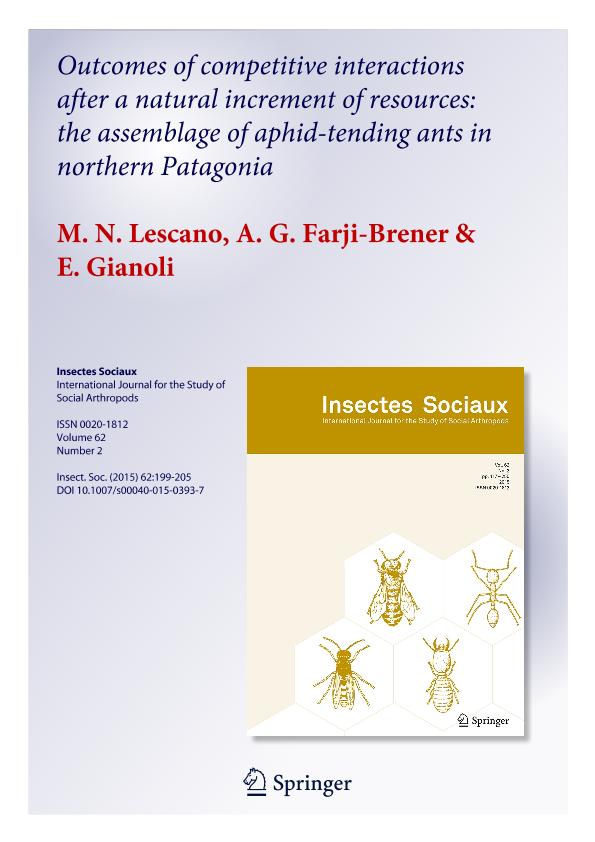Mostrar el registro sencillo del ítem
dc.contributor.author
Lescano, María Natalia

dc.contributor.author
Farji Brener, Alejandro Gustavo

dc.contributor.author
Gianoli, E.
dc.date.available
2017-01-27T20:56:36Z
dc.date.issued
2015-05
dc.identifier.citation
Lescano, María Natalia; Farji Brener, Alejandro Gustavo; Gianoli, E.; Outcomes of competitive interactions after a natural increment of resources: the assemblage of aphid-tending ants in northern Patagonia; Springer; Insectes Sociaux; 62; 2; 5-2015; 199-205
dc.identifier.issn
0020-1812
dc.identifier.uri
http://hdl.handle.net/11336/12125
dc.description.abstract
Ant-aphid relationships provide excellent opportunities to study how changes in resource availability may affect the outcome of competitive interactions. Variations in soil fertility may affect host plant quality, with concomitant effects on aphid abundance and the amount/ quality of aphid honeydew. This may determine the intensity at which tending ants defend aphids against natural enemies and competing ants. In a shrub-steppe of northern Patagonia, aphid-infested thistles naturally grow on contrasting fertility substrates: organic waste piles of leafcutting ants (refuse dumps) and nutrient-poor steppe soils. Thistles growing on refuse dumps have much larger aphid colonies than thistles growing on steppe soils. We took advantage of the co-occurrence in the field of plants with contrasting aphid density to study the effect of natural variation in food availability (aphid density) on aphidtending ant species richness and agonistic interactions among them. Enhanced aphid density did not promote the coexistence of aphid-tending ant species. Although all ant species are potential colonizers of the study plants, thistles were often monopolized by a single ant species, regardless of aphid density. Field experiments showed that increased aphid density did not modify aggressiveness toward an intruder ant, nor the probability of coexistence between two rival ant species after the invasion of a host plant. We discuss several hypotheses to explain why increased resource availability does not necessarily reduce competitive interactions in ant-aphid relationships.
dc.format
application/pdf
dc.language.iso
eng
dc.publisher
Springer

dc.rights
info:eu-repo/semantics/openAccess
dc.rights.uri
https://creativecommons.org/licenses/by-nc-sa/2.5/ar/
dc.subject
Agressive Behaviour
dc.subject
Ant Communities
dc.subject
Competitive Interactions
dc.subject
Resource Availability
dc.subject.classification
Zoología, Ornitología, Entomología, Etología

dc.subject.classification
Ciencias Biológicas

dc.subject.classification
CIENCIAS NATURALES Y EXACTAS

dc.title
Outcomes of competitive interactions after a natural increment of resources: the assemblage of aphid-tending ants in northern Patagonia
dc.type
info:eu-repo/semantics/article
dc.type
info:ar-repo/semantics/artículo
dc.type
info:eu-repo/semantics/publishedVersion
dc.date.updated
2016-12-12T14:29:19Z
dc.identifier.eissn
1420-9098
dc.journal.volume
62
dc.journal.number
2
dc.journal.pagination
199-205
dc.journal.pais
Suiza

dc.journal.ciudad
Basilea
dc.description.fil
Fil: Lescano, María Natalia. Consejo Nacional de Investigaciones Científicas y Técnicas. Centro Científico Tecnológico Patagonia Norte. Instituto de Investigación En Biodiversidad y Medioambiente; Argentina. Universidad Nacional del Comahue. Centro Regional Universitario Bariloche. Laboratorio de Ecotono; Argentina
dc.description.fil
Fil: Farji Brener, Alejandro Gustavo. Consejo Nacional de Investigaciones Científicas y Técnicas. Centro Científico Tecnológico Patagonia Norte. Instituto de Investigación En Biodiversidad y Medioambiente; Argentina. Universidad Nacional del Comahue. Centro Regional Universitario Bariloche. Laboratorio de Ecotono; Argentina
dc.description.fil
Fil: Gianoli, E.. Universidad de Concepcion. Facultad de Cs Naturales y Oceanografia. Departamento de Botanica. Lab de Ecologia Funcional; Chile. Universidad de la Serena; Chile
dc.journal.title
Insectes Sociaux

dc.relation.alternativeid
info:eu-repo/semantics/altIdentifier/doi/http://dx.doi.org/10.1007/s00040-015-0393-7
dc.relation.alternativeid
info:eu-repo/semantics/altIdentifier/url/http://link.springer.com/article/10.1007%2Fs00040-015-0393-7
Archivos asociados
